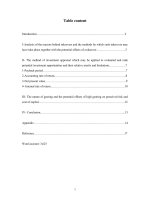Kế toán công cụ. Bản chất của đòn bẩy tài chính và những tác động tiềm năng lớn về nhận thức rủi ro và chi phí vốn
Bạn đang xem bản rút gọn của tài liệu. Xem và tải ngay bản đầy đủ của tài liệu tại đây (159.33 KB, 17 trang )
Table content
Introduction………………………………………………………………………………2
I-Analysis of the reasons behind takeovers and the methods by which such takeovers may
have take place together with the potential effects of a takeover………………………...3
II- The method of investment appraisal which may be applied to evaluated and rank
potential investment opportunities and their relative merits and limitations……………..7
1-Payback period………………………………………………………………………….7
2-Accounting rate of return……………………………………………………………….8
3-Net present value………………………………………………………………………..9
4- Internal rate of return………………………………………………………………….10
III- The nature of gearing and the potential effects of high gearing on perceived risk and
cost of capital…………………………………………………………………………….12
IV- Conclusion…………………………………………………………………………...13
Appendix…………………………………………………………………………………14
Reference………………………………………………………………………………...17
Word account: 3,625
1
Introdcution:
Jebb Plc wants to takeover a rival company in which they believe will be successful in
increasing the wealth of shareholders. Due to understanding of limited fund, managers of
Jebb PLC are going to raise money through increasing debts in order to acquire target’
firm. As a senior financial manager in Jebb PLC, I have to prepare a report to analysis
reasons behind takeovers and the methods by which such takeovers may take places
together with the potential effects of a takeover. Then, I will give four method of
investment appraisal to evaluated and rank potential investment opportunities and their
merits and limitation. Moreover, the nature of gearing and potential effected of high
gearing on perceived risk and cost of capital.
2
I-Analysis of the reasons behind takeovers and the methods by which such takeovers
may have take place together with the potential effects of a takeover.
‘Takeover’ is referring to transfer of control of a firm from one group of shareholders
to another group of shareholders. It is a change in the controlling interest of corporation,
either through a friendly acquisition or unfriendly, hostile, bid. A hostile takeover with the
aim of replacing current existing management is usually attempted through a public tender
offer. (asia.advfn.com)
Next following below I will give reasons for takeover company.
• Defensive. Some acquisitions take place because the buyer is itself the target of another
company, and simply wants to make itself less attractive through acquisition.
• Intellectual property includes patents, trademarks, production processes, and
databases. This is defensible knowledge base that gives a company a competitive
advantage, and is one of the best reasons to acquire a company.
• International alternative. A company may have an extremely difficult time creating new
products. And so looks elsewhere to find replacement products. This issue is especially
likely to trigger an acquisition of a company has just decided to cancel an in-house
development project, and needs a replacement immediately.
• Market growth. Buyer can not grow revenues quickly in a slow-growth market, because
there have few sales to be made. In contrast, a target company may be suitable in a
market that is growing faster than the buyer itself. Hence, the buyer can see rapid
growth when acquire target Company.
• Market share. In general, companies all look toward a high market share, because it
allows them to have advantage in price competitive. The acquisition of a large
competitor is a reasonable way to quickly attain significant market share.
• Production capacity. The buyer may have excess production capacity available, from
which it can readily manufacture the target’s products. Moreover, the target company
may have an excellent product that the buyer can use to fill a hold in its own product
line. This is an especially important reason when the market is expanding rapidly, and
the buyer does not have time to develop its product before others compete and take
over the market.
3
• Sales channels. A target company may have an effective sales channel that buyer think
can use to distribute its products. Besides, the target sales staff might be effective so
that it may be the prime reason for an acquisition offer.
• Vertical integration. This is use in security term. The buyer may want to secure its
supply lines by acquiring selected suppliers. It is important when supplier has to
control over a large proportion of demands. In addition to backward integration,
company can engage in forward integration by acquiring a distributor or customer.
This most commonly occurs with distributors, especially when they have good
relationship with customers (Accountingtool)
Thirdly, I will give some method to takeover the target’s company. There are 4 methods to
takeover a company: cash offers, share-for-share offers, mixed bids and security package.
• Cash offers. Public offering of security issue to every interested investor, with or
without involving an underwriter. In contrast, a right issue is offered only to the current
stockholders. General cash offer is the most common method of selling debt (bond) and
equity (stock) issues. According to the SEC Rule 415 (1982), a large firm can file a
single new issue registration statement that is valid for two years. Within this period the
firm can make general cash offer as and when it wants. (investorword.com)
Cash-offer attracts a target company shareholder because it provides shareholders with
significant, immediate and certain value for the buyer’s existing assets, as well as its future
growth potential. Besides, cash-offer adjusts company’s portfolios, its operation and
development capabilities and strong balance sheet. (transalta.com)
Advantage of using cash-offer is that company can determine the outcome. However, its
disadvantage that cash offer to acquire target’s company may insufficient and in case
company borrows money from bank, the interest rate changes must be considered.
• Share-for-share offers. Takeover bid in which the acquiring firm offers its shares for an
equal number of shares in the target firm. It accepted. Shareholders of the both pre-
merger firms become owners of the resulting firm (Businessdictionary.com)
A shareholder must take an offer when its shareholding, including that of parties acting
reaches 30% of the target. Information relating to the bid must not be released except by
announcements regulated by the Code. The bidder must make an announcement if rumor
speculation has affected a company’s share price. If shares are bought during the offer
4
period at a price higher than the offer price, the offer must be increased to that price.
(Business&Financemarket.)
• Mixed bids are where share for share offer is supported by a cash alternative. This
method is being acceptable to company’s targeted shareholder.
• Security packages. Projects involve risks for all parties. The ability of the parties to
agree on how risks will be shared is often the key to initiating a successful project. In
order to reduce the risk particularly for all parties, a security package is established
through the various agreements, contractors, undertaking and the guarantees. Buyer
looks to the security package agreement in order to provide security for money the
investment and target’s company assets. There preparation of the key agreement must
be coordinated in order to avoid conflicts and provision of interlocking among these
agreements should be made.(assessmylibrary.com)
Fourthly, I will analysis and explain impacts that effect when Jebb PLC takeover rivals.
When a company wants to takeover a target firm, there are some influences affect
management, employees, financial, stockholder and economy of scale.
• Management. When a change in company control takeover often the corporation who
becomes in charge often prefers to bring in their own staff members to assimilate and
become the decision makers of their newly acquired business. As a result of the
acquisition the original management may be dismissed or given notice. In case, the
current management is allowed to stay there is a good possibility things may not
continue per the norm and managers may find themselves having to adjust to new
policies, practices and an overall different way of doing things; the transition that
occurs with a change of control can be difficult.(helium.com)
• Employees. They are people who also go through a lot when takeover occurs. With a
shift of control/ownership comes lots of organizational change, sometimes new bosses,
loss of job and an over attitude of ‘out with the old. In with the new’. Sometimes the
change entails letting easy on everyone. Other times the new corporation maintains
some employees for good or to train their own people. Whatever the decision on
employees, this can have a serious impact on employee morale. (helium.com)
• Financial. Ansof (1971) found that after an acquisition, low sales growth companies
showed significantly higher rates of growth, whereas, high sales growth companies
5
showed lower rates of growth. However, even though low sales growth companies
showed higher rates of growth after acquisitions, they actually suffered decreases in
their mean P/E ratios, mean EPS and mean dividend payouts. The similar pattern of
inconsistency found in the high sales growth companies whereby their performance
levels for EPS, PE ratio, earning and dividend payouts were greater. Low sales growth
companies financed their acquisitions through decreased dividend payouts and the use
of new debts. In contrast, high sales growth companies with other strategies tended to
decrease debts but increase dividend payouts. (international business and management)
• Stockholders have such a vested financial stake in the corporations they own stock in
that a takeover affection. The company may falter or thrive and either way this affects
the bottom line of their investment.
• Economy of scale. According to Ansof (1971), acquisitions were in general
unprofitable, as they did not contribute to increase in all of the variables of companies’
growth. However, follow Ajit Singh, after a two-year period of takeover, there was
deterioration in relative profitability record. He added that as in relation to EPS, the
biggest potential losers are shareholders in biding companies who were sacrificing
profits for future growth. Those acquiring firms could have maintained their
profitability records if they were not involved in takeovers and large companies tended
to engage in higher gearing and this led to higher retention ratio and eventually higher
growth is attained. (international business and management)
II- The method of investment appraisal which may be applied to evaluated and rank
potential investment opportunities and their relative merits and limitations.
In this report, I will give 4 methods to evaluate and rank potential investment opportunities.
They are: payback period, ARR, NPV, and IRR
1-Payback period (PP)
6









